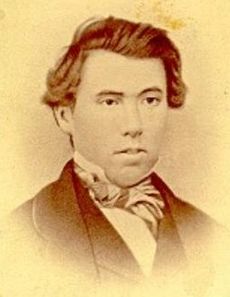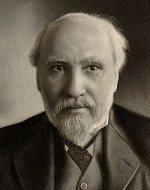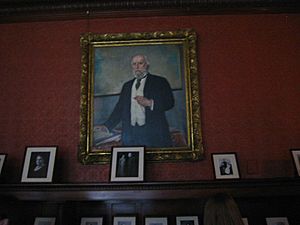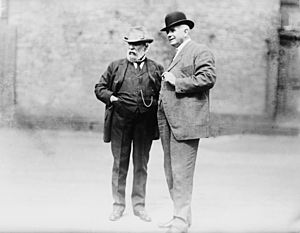James J. Hill facts for kids
Quick facts for kids
James J. Hill
|
|
|---|---|
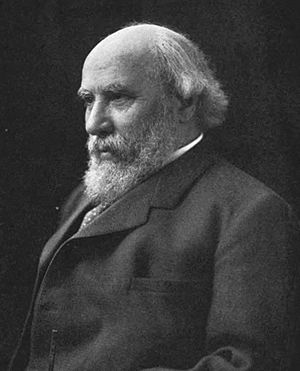 |
|
| Born |
James Jerome Hill
September 16, 1838 Eramosa Township, Upper Canada
|
| Died | May 29, 1916 (aged 77) St. Paul, Minnesota, U.S.
|
| Nationality | Canadian-American |
| Occupation | Railroad tycoon |
| Spouse(s) | Mary Theresa Mehegan |
| Children | 10 |
| Relatives | Louis Warren Hill Jr. (grandson) |
| Signature | |
 |
|
James Jerome Hill (born September 16, 1838 – died May 29, 1916) was a very important person in the history of railroads in North America. He was the main leader of a group of train lines, especially the Great Northern Railway. This railway served a huge area in the central and western United States. Because his railway empire was so big, people called him "The Empire Builder."
Contents
Biography
Early Life and Education
James Hill was born on September 16, 1838, in a place called Eramosa Township in what is now Ontario, Canada. When he was a child, an accident with a bow and arrow caused him to lose sight in his right eye. He went to school for nine years, even getting free lessons at Rockwood Academy for a short time. He had to leave school in 1852 because his father passed away. By then, he was very good at math, surveying land, and English. These skills helped him a lot in his future career.
After working as a clerk in Kentucky, Hill decided to move to the United States permanently. He settled in St. Paul, Minnesota, when he was 18 years old. His first job there was as a bookkeeper for a steamboat company. By 1860, he worked for grocery stores, handling how goods were moved by trains and steamboats. This job taught him everything about the shipping and transportation business. During winters, when the Mississippi River froze and steamboats couldn't run, Hill started taking on other jobs and won several contracts.
Becoming a Young Businessman
Because he knew a lot about shipping and fuel, Hill started his own coal and steamboat businesses. In 1870, he and his partners created the Red River Transportation Company. This company offered steamboat trips between St. Paul and Winnipeg. By 1879, he had bought out other companies and had a local monopoly (meaning he was the only one offering that service).
In 1867, Hill also got into the coal business. By 1879, it had grown five times bigger, giving him control over the local anthracite coal market. During this time, Hill also became involved in banking. He quickly joined the boards of directors for several big banks. He also bought businesses that were failing, made them successful again, and then sold them for a lot of money. Hill said his secret was "work, hard work, intelligent work, and then more work."
Entering the Railroad Business
During a tough economic time called the Panic of 1873, many railroads went bankrupt. One of them was the St. Paul and Pacific Railroad (StP&P). This railroad was in a lot of legal trouble. For James Hill, this was a great chance. For three years, Hill studied the StP&P. He realized he could make a lot of money from it if he could find the starting money.
Hill teamed up with some partners, including Norman Kittson and Donald Smith. Together, they bought the railroad. They also made it much bigger by making deals to use tracks from the Northern Pacific Railway. In May 1879, the St. Paul, Minneapolis, and Manitoba Railway Co. (StPM&M) was formed, with James J. Hill as its general manager. His first goal was to expand and improve the railway even more.
Hill was a very hands-on manager. He paid close attention to every detail. He wanted people to settle along his railway lines. So, he sold land to immigrants and transported them to their new homes using his trains. When he was looking for the best path for a new track, he would ride on horseback and check it himself. Under his leadership, the StPM&M became very successful. In 1880, it was worth $728,000. By 1885, it was worth $25,000,000!
One of his challenges was to avoid the government getting involved with railroads. If the government thought railroads were making too much money, they might force them to lower their prices. Hill avoided this by putting a lot of the railroad's profits back into improving the railroad itself. He then listed these improvements as operating costs. At this point, Hill became the official president of StPM&M and decided to expand the rail lines even further.
The "Empire Builder"
Between 1883 and 1889, Hill built his railroads across Minnesota, into Wisconsin, and across North Dakota to Montana.
If there wasn't enough business in the areas where Hill was building, he would bring in new industries. He often bought companies and built factories along his railway lines. By 1889, Hill decided his future was in building a transcontinental railroad. This is a railway that crosses an entire continent.
Hill famously said, "What we want is the best possible line, shortest distance, lowest grades, and least curvature we can build." He got what he wanted. In January 1893, his Great Northern Railway was finished. It ran from St. Paul, Minnesota, to Seattle, Washington, a distance of over 1,700 miles (2,700 km). The Great Northern was special because it was the first transcontinental railroad built without public money. It was also one of the few transcontinental railroads that did not go bankrupt.
Hill chose to build his railroad north of a competing line, the Northern Pacific. The Northern Pacific had to cross much harder land with more bridges and steep hills. Hill did much of the route planning himself, riding horses over possible paths. A key part of the Great Northern line was Hill's use of the Marias Pass. This pass had been described by Lewis and Clark in 1805, but no one had found it since. Hill hired someone named Santiago Jameson to find it. Jameson found the pass in 1889. This discovery shortened the Great Northern's route by almost one hundred miles.
The Great Northern reached Seattle on January 7, 1893.
In 1898, Hill bought control of large parts of the Mesabi Range iron mining area in Minnesota. He also bought its railway lines. The Great Northern then started shipping huge amounts of iron ore to steel factories in the Midwest.
Encouraging Settlements
The Great Northern actively encouraged people to settle along its lines in North Dakota and Montana. Many of these settlers were Germans and Scandinavians from Europe. The Great Northern bought its land from the government and sold it to farmers at low prices. It even had offices in Germany and Scandinavia to promote its lands. It brought families over at a low cost. Hill also helped start schools and churches for these communities. He promoted new farming methods to help them succeed. This led to a "Dakota Boom" in 1882, when 42,000 immigrants, mostly from northern Europe, moved into the Red River Valley.
Hill's Railways in the 1890s
Six months after the railroad reached Seattle, a big economic downturn called the Panic of 1893 hit the country. Hill's leadership during this time became an example of how to successfully manage a big business during tough economic times. To make sure he didn't lose customers, Hill lowered shipping prices for farmers. He also gave credit to many of the businesses he owned so they could keep paying their workers. He even offered a "$10 trip" for immigrants.
Hill also took strong steps to save money. In just one year, he cut the cost of carrying a ton of freight by 13%. Because of these actions, Hill not only stayed in business but also increased the value of his railroad by almost $10,000,000. Meanwhile, almost every other transcontinental railroad went bankrupt. His ability to get through the tough times made him famous and admired. Hill also saved money by cutting wages, which was possible because prices were generally falling at that time.
Around 1893, Hill started looking for workers other than Chinese laborers. For a short time, he hired Italian and Greek workers, but the company wasn't happy with their work. Hill sent people to the Pacific to find new trade opportunities. They found that Japan had the most potential for "Oriental Trade," and he decided to take advantage of this.
At this time, he also started focusing on trade with Asian countries. He offered Japanese businesses cotton from the Southern U.S. He even shipped it for free if they would compare it to the cotton they were using. If they were unhappy, he promised a refund, but they were satisfied. With these good relationships, Hill managed to get an order from Japan for 15,000 tons of rails, beating out competition from England and Belgium. From 1886 to 1905, American exports to Japan jumped from $7.7 million a year to $51.7 million.
The Northern Pacific and the "Short Squeeze" of 1901
By 1901, James Hill controlled both the Great Northern Railway and the Northern Pacific Railway. He had gotten the Northern Pacific with help from his friend J. P. Morgan when that railroad went bankrupt. Hill also wanted control of the Chicago, Burlington and Quincy Railroad because it had important lines in the Midwest and access to Chicago. The Union Pacific Railroad was the biggest competitor to Hill's railways. While Great Northern and Northern Pacific were supported by J. P. Morgan and James J. Hill, the Union Pacific was backed by its president, Edward H. Harriman, and powerful people like William Rockefeller.
Quietly, Harriman started buying stock in Northern Pacific. His goal was to gain control of the Chicago, Burlington, and Quincy. He was only 40,000 shares away from control when Hill found out. Hill quickly contacted J. P. Morgan, who told his team to buy as much Northern Pacific stock as they could.
This caused a lot of confusion and panic on Wall Street. Northern Pacific stock prices shot up to $1,000 per share. Many investors who had bet that the stock price would fall faced financial ruin. There was a real threat of a major economic panic. Neither side could win a clear advantage, so they decided to make a truce. The winners of this truce were Hill and Morgan. They immediately formed the Northern Securities Company. Their goal was to combine their three main railway lines.
As the Hill-Morgan alliance formed the Northern Securities Company, Theodore Roosevelt became president. He started to fight against big companies that were creating monopolies (controlling all of a certain business).
Hill's Companies Survive Government Action
President Roosevelt's Justice Department sued the Northern Securities Company in 1902. The Supreme Court later ordered it to be broken up in 1904 because it was a monopoly. (Interestingly, the Burlington Route, Northern Pacific, and Great Northern would later merge in 1970 to form the Burlington Northern Railroad.) This decision made it harder for Hill to offer competitive prices for trade with Asian countries. In the next two years, American trade with Japan and China dropped by 40%.
Hill continued to expand his business without a central company. He bought the Colorado and Southern Railway lines into Texas. He also built the Spokane, Portland and Seattle Railway. By the time he died in 1916, James J. Hill was worth more than $53 million. When his money was divided, his wife received over $16 million, and each of his children received almost $4 million.
The Great Northern Railway and the Northern Pacific tried to merge four times. Their last attempt lasted from 1955 until the Supreme Court approved it in March 1970. This created the Burlington Northern Railroad. In 1995, Burlington Northern merged with the Atchison, Topeka and Santa Fe Railway to become the Burlington Northern and Santa Fe Railway.
Family Life
In 1867, James J. Hill married Mary Theresa Mehegan. She was born in New York City in 1846. They had ten children:
- Mary Francis Hill Hill (1869–1947), who married Samuel Hill.
- James Norman Hill (1870–1932).
- Louis Warren Hill (1872–1948), who became president of the Great Northern Railway in 1907.
- Clara Anne Hill Lindley (1873–1947).
- Katherine Theresa Hill (1875–1876) (died as a baby).
- Charlotte Elizabeth Hill Slade (1877–1923).
- Ruth Hill Beard (1879–1959).
- Rachel Hill Boeckmann (1881–1967).
- Gertrude Hill Gavin (1883–1961).
- Walter Jerome Hill (1885–1944). A town called Walthill, Nebraska, was named after Walter.
Death
By early 1916, Hill started focusing more on giving money to good causes. He donated thousands of dollars to different organizations. At the same time, he was privately struggling with health problems that were getting worse. His condition quickly got worse in mid-May. Even with help from many respected doctors, he could not be saved. After falling into a coma, he died at his home in St. Paul, Minnesota, on May 29, 1916. Mary Hill died in 1922 and was buried next to her husband. Later, both graves were moved to Resurrection Cemetery for safety.
Hill's Legacy
James J. Hill was a very important person in American business and history. He was a supporter of free trade, which means he believed in trading goods between countries without many restrictions. He was one of the few people who supported free trade with Canada.
In St. Paul, the city's main library and the Hill Business Library were funded by him. He also gave money to many schools, including the Saint Paul Seminary. Hill was a member of the Jekyll Island Club, also known as The Millionaires Club, in Jekyll Island, Georgia.
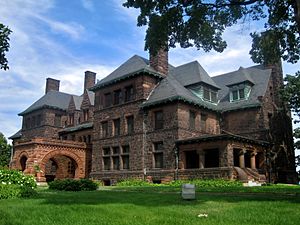
In 1891, after three years of building, Hill's new family home was finished at 240 Summit Avenue in St. Paul. Over 400 workers built the house. It cost $930,000 and had 36,000 square feet (3,300 m2). The James J. Hill House was one of the biggest homes in the city. Just like with his businesses, Hill oversaw the building and design himself. He even hired and fired several architects during the process. The house had many early electrical and mechanical systems that were new for homes at that time. After his wife died in 1921, the house was given to the Roman Catholic Archdiocese of Saint Paul and Minneapolis. Today, it is operated as a museum and gallery by the Minnesota Historical Society.
Even though Hill was a Protestant, he had a strong relationship with the Catholic Church in St. Paul. The Hills were close with Archbishop John Ireland. Hill gave a lot of money to the Saint Paul Seminary, Macalester College, Hamline University, the University of St. Thomas, Carleton College, and other educational and charity groups.
To create business for his railroad, Hill encouraged European immigrants to settle along his railway line. He often paid for Russian and Scandinavian settlers to travel from Europe. To help his rail business grow, Hill experimented with farming. He worked to create new types of Russian wheat that would grow well in the soil and weather of Dakota. He also ran model farms in Minnesota, like North Oaks, to develop better livestock and crops for the settlers near his railroads.
Hill was also very interested in protecting nature. President Theodore Roosevelt invited him to a conference about conserving natural resources.
Near the end of his life, Hill played a very important role during World War I. After the first difficult year of the war, the Allied Powers (like England and France) desperately needed money to keep fighting. Hill was a major figure in the effort led by J.P. Morgan to create the Anglo-French Bond drive of 1915. This allowed the Allies to buy much-needed food and supplies. This trade with England and France helped the United States economy grow from a tough time in 1914 to boom years in 1915 and 1916.
Several places are named after him, including Hillsboro, North Dakota; Hill County, Montana; and Hillyard, Washington. Jim Hill Mountain in the Cascade Range is also named after him. A common weed in wheat fields, Sisymbrium altissimum, is also called "Jim Hill Mustard." Farmers believed it spread from seeds that fell out of railway cars on the lines he controlled.
In 1929, the Great Northern Railway started a long-distance passenger train from Chicago to Seattle. They named it the Empire Builder in his honor. This train was the Great Northern's most important train and is still used today by Amtrak. The James J. Hill House in St. Paul is a National Historic Landmark.
In 1887, the Great Northern's first company headquarters building was built in St. Paul. Hill had seen the damage caused by the Great Chicago Fire. Because of this, he made sure the 1887 headquarters building had special barrel-shaped ceilings made of brick and steel rails. These held a layer of sand several inches deep. The idea was that if a fire broke out and the ceiling collapsed, the sand would fall and help stop the fire.
Hill was also deeply involved in planning a new company headquarters in St. Paul, built from 1914 to 1916. This 14-story building cost $14 million and was meant to house the offices of the Great Northern, Northern Pacific, and Hill's banking businesses.
Hill's family created the James J. Hill Reference Library in St. Paul. This library is known as a top place for business information in the United States. It helps many small businesses get the information they need.
In 1959, Hill High in St. Paul, Minnesota, was started as a school using money set aside by Hill's wife for education. This all-male school later joined with an all-female school in 1971 to form Hill-Murray School.
In 1958, he was honored by being added to the Hall of Great Westerners at the National Cowboy & Western Heritage Museum.
A statue of Hill is located on the University of Washington campus in Seattle, Washington.
See also
 In Spanish: James J. Hill para niños
In Spanish: James J. Hill para niños
- Charles T. Hinde
- Pierce Butler (justice)
- List of railroad executives
- James J. Hill Sapphire


